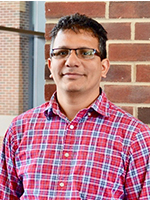

 Ramesh Giri
Ramesh Giri
The Pennsylvania State University
报告时间:2025年10月17日 下午2:00~5:00
报告地点:6号楼2楼宣讲厅
邀请人:杨国强 副教授
报告摘要
Simultaneous generation of two new carbon-carbon bonds across C(sp2)-carbons in alkenes is a powerful strategy to create complex products from simple starting materials. However, execution of this process is fundamentally challenging because of slower kinetics for the migratory insertion of unactivated alkenes than cross-coupling, and faster kinetics of b-H elimination from alkylmetal intermediates than transmetalation/reductive elimination. In this talk, we introduce strategies with transition metal and photoredox chemistry that address these fundamental issues during alkene difunctionalization. Mechanistic pathways relevant to these new reactions will also be discussed.
报告人介绍
Ramesh Giri was born in Chitwan, Nepal and graduated with distinction from Tribhuvan University (Nepal) with an MSc in Organic Chemistry in 2000 under the supervision of Prof. S. M. Tuladhar. As a Shell Centenary Scholar, he received his MPhil in Bioorganic Chemistry in 2003 from the University of Cambridge (UK) with Prof. J. B. Spencer. He earned his PhD in Chemistry from The Scripps Research Institute in 2009 with Prof. Jin-Quan Yu, where he studied Pd-catalyzed C-H functionalization. As a postdoctoral fellow in the research laboratory of Prof. John F. Hartwig at UC Berkeley/UIUC, he conducted mechanistic studies on Ullmann amination and biaryl ether forming processes. In 2012, he joined the faculty of the Department of Chemistry and Chemical Biology at the University of New Mexico as an Assistant Professor. Currently, Giri is a professor at The Pennsylvania State University. Professor Giri’s research group is interested in developing transition metal-catalyzed organic transformations and investigating their reaction mechanisms. Particularly, his group is interested in identifying and solving chemical problems that have broad impacts in the areas of energy, materials and health. His group is adopting innovative strategies to develop new reactions that utilize the unique properties of transition metals in different oxidation states in order to solve these problems. In this front, much of his research group’s work focuses on the design and synthesis of new hybrid ligands/catalysts.








